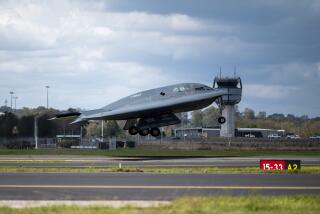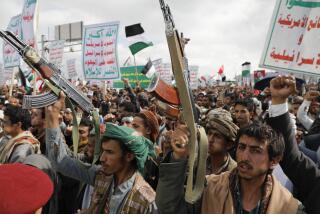U.S. concerned about former Guantanamo prisoners in Yemen
- Share via
Reporting from Washington — As the U.S. ratchets up security on cargo packages and digs deeper into the plot to send bombs from Yemen, officials are concerned that a number of high-ranking members of Al Qaeda in Yemen were released from the U.S. prison at Guantanamo Bay, Cuba, to a Saudi rehabilitation program for militants.
The No. 2 leader for the group in Yemen is Saudi national Said Shihri, who was captured by the U.S. in Afghanistan in 2001 and released from Guantanamo in 2007 to the Saudi program. He was featured in a 2009 video announcing the merger of the Saudi Arabian and Yemeni branches of Al Qaeda. His brother was killed in an October 2009 shootout on the Yemeni border while attempting to smuggle suicide vests into Saudi Arabia.
The Saudis have told U.S. officials that the four-step rehabilitation program has an 80% success rate at reforming militants once held by the U.S. But U.S. intelligence officials note that a crucial cadre of those who were released have slipped over the border into Yemen and become key figures in Al Qaeda in the Arabian Peninsula.
“A hard-core group of terrorists have either fooled the system or beat the system, and that is a concern,” said Rep. Jane Harman (D-Venice).
The sophisticated bombs discovered last week hidden inside desktop printers bear the hallmarks of a bomb maker in the Yemeni organization. Ibrahim Hassan Asiri is a Saudi fugitive but has not been held in Guantanamo.
Another figure of concern is Uthman Ghamdi, who was released from Guantanamo into the Saudi program in 2006 and is considered a close aide to the American-born cleric Anwar Awlaki, who has become a master strategist and propagandist for Al Qaeda in Yemen. Ghamdi wrote a passage in the jihadi online magazine Inspire, released in October, describing his flight to Guantanamo on a cargo plane.
Last January, the Obama administration suspended transfers of Guantanamo detainees to Yemen after learning that the man accused of trying to set off a bomb last Christmas on a Detroit-bound plane had received training from Al Qaeda there. The Pentagon also announced that it would not repatriate any more Saudi detainees from Guantanamo.
The changes were made after disclosure of a Pentagon report that estimated one-fifth of the detainees who have been released from the U.S. military prison at Guantanamo have taken up extremist activity.
In 2009, Saudi Arabia released a list of its 85 most wanted terrorists. Of those, seven who were held in Guantanamo and released from the Saudi program are believed to be at large in Yemen, according to Christopher Boucek, an associate at the Carnegie Endowment for International Peace who has researched the impact of Saudi Arabia’s rehabilitation programs.
“There are people who cannot be rehabilitated,” Boucek said. The program “is not a silver bullet. It is part of a bigger effort.”
There is a question about whether some of the jihadists who were released from the Saudi rehabilitation program and returned to Al Qaeda became double agents helping the Saudi government. Jabir Jubran Fayfi, a former Guantanamo detainee who was released through the program, rejoined Al Qaeda in 2006. Then the Saudi Interior Ministry announced Oct. 15 that Fayfi had surrendered in Yemen. Fayfi reportedly was the source of the intelligence that stopped the package bomb plot.
To combat the immediate threat in Yemen, the U.S. has halted all mail from the country. It has also deployed a six-person team of Transportation Security Administration trainers and technicians with scanning equipment to Yemen to ensure that, when the mail resumes, any cargo leaving that country for the U.S. will be carefully checked.
Members of Congress are already squaring off about whether more legislation is needed to tighten the screening of cargo, or whether to allocate additional resources to the Department of Homeland Security instead.
Rep. Edward J. Markey (D-Mass.) plans to introduce a new cargo-screening law when Congress reconvenes Nov. 15. “America’s aviation system remains at the top of Al Qaeda’s terrorist target list,” Markey said Monday. “The cargo industry and business community must recognize more needs to be done to secure cargo planes.”
Some representatives, such as Michael McCaul (R- Texas), are hesitant to pass additional legislation. He would prefer that Homeland Security have greater resources and flexibility to increase inspections of cargo planes. He also would like the TSA to accelerate efforts to inspect 100% of cargo on passenger planes coming to the U.S., a level scheduled to be accomplished in 2012.
“I’m not sure more legislation is needed,” McCaul said. “The response has to be threat-based.”
The most recent law governing cargo screening on passenger planes was passed in 2007.
Markey has long been frustrated at what he sees as industry reluctance to tackle the vulnerabilities of air cargo shipping.
In response to legislative efforts in 2007, a consortium of 18 industry lobbying organizations wrote, “There is no existing technology to allow for efficient inspection of 100% of air cargo.”
The lack of technology to efficiently screen all cargo coming into the U.S. has posed a challenge to the TSA goal of screening all inbound cargo by 2013.
“We have tackled the issue of vulnerability,” said David Castelveter, vice president for communications for the Air Transport Assn., pointing to the industry’s success in meeting the TSA’s requirement for 100% screening of domestic cargo in August 2010. “We’d like to weigh in on any changes that might be considered after this, but we’re transporters. We abide by the rules.”
Inspections can go only so far. The disruption of the Yemen bomb plot, Harman said, shows what a “crucial tool it is to have active and accurate intelligence. I am for making sure we have the best intelligence we can field.”
“There is a lot that we can do through inspections, but it won’t solve this problem,” said UCLA professor emeritus Michael D. Intriligator. “They still have the goal of killing 3 million Americans. There is no way to ensure our protection. It’s physically impossible. We are a porous country with a lot of openings. We’re not prepared for it.”
In the days since the package bomb threat came to light, air passenger screenings have increased. In a move that has been in the works for months, the TSA instituted a new, more thorough pat-down search procedure at airports nationwide over the weekend.
The procedure, which was tested at airports in Boston and Las Vegas this summer, allows officers to pat down passengers with the fronts of their hands to feel for objects that may be hidden under clothing. In the past, TSA officials used only the backs of their hands to check for such objects around a passenger’s chest and groin.
The pat-down procedure is being used on passengers who choose not to be screened by the 317 new full-body scanners that are deployed at 65 airports nationwide. The scanners use low doses of either radio waves or X-rays to produce what resembles a nude image of the passenger to find weapons hidden under clothing.
A spokesman for the ACLU complained Monday about the new pat-down procedure, saying passengers have an unhappy choice between going through a full-body scanner or undergoing a pat-down search.
“Americans now must choose between a virtual strip search and a grope,” said Chris Calabrese, legislative counsel to the ACLU. He declined to say whether the ACLU would file a legal challenge to the new procedure, but he said the ACLU would accept complaints from passengers about the procedure on its website.
Staff writers David S. Cloud and Richard A. Serrano in Washington and Ronald D. White and Hugo Martin in Los Angeles contributed to this report.
More to Read
Sign up for Essential California
The most important California stories and recommendations in your inbox every morning.
You may occasionally receive promotional content from the Los Angeles Times.











